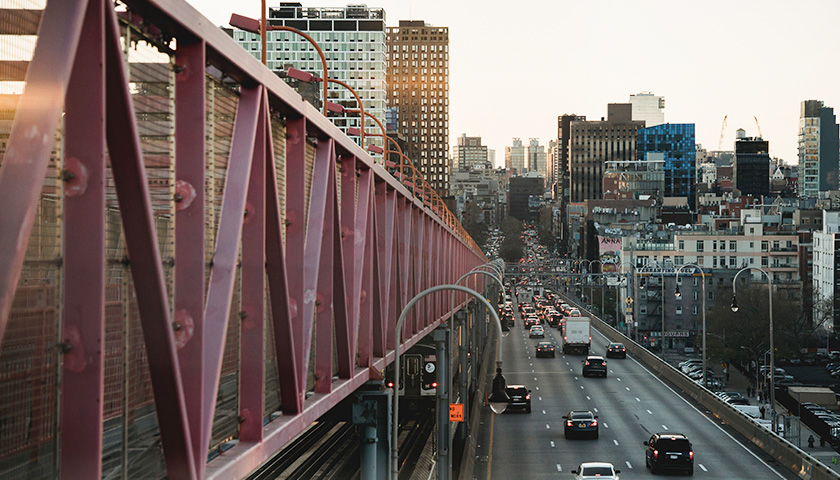by Edward Ring
After I’d chastised him repeatedly for being the spoiler in the November 2020 battle between Republican David Perdue and Democrat Jon Ossoff to represent Georgia in the U.S. Senate, Shane Hazel invited me to debate him on his podcast.
During our lengthy discussion, Hazel demonstrated a thorough knowledge of the U.S. Constitution, and we found ourselves in agreement on many if not most of the critical issues, starting with the First and Second Amendments. One topic I wish we could have spent more time discussing was the issue of infrastructure. As it was, I got nowhere with Hazel on that question.
Infrastructure requires careful definition these days. Leftists have recently repurposed the word to describe not pipelines and power grids but social services and public education. Where leftists trod, moderate Democrats and RINOs have followed, muddying the meaning by imposing a broad concept onto what should be straightforward and tangible. This isn’t a trivial problem, because infrastructure, traditionally defined, demands painful clarity from ideologues committed to limited government.
For example, if you are going to build a pipeline to transport natural gas from wells to refineries and from there to end users, you have to lay the pipe in a route that minimizes material waste. The same reality holds true for high-voltage power lines, freeways, and railroads. Without the ability of government to exercise eminent domain, it would be impossible to secure easements to build these necessary assets.
Even infrastructure built with private funding, such as toll roads, can’t be constructed without eminent domain. Without that legal authority, one private landowner occupying a small parcel in the path of a project could stop it cold.
The moral worth of eminent domain falls along a continuum, and where the line is drawn between justified versus unjustified use is subjective. Necessary pipelines, aqueducts, and power lines are on one end, and sports stadiums, “redevelopment,” and urban renewal are on the other. And even in those less justifiable categories, history is filled with examples of glorious rebuilt cities arising on top of decaying slums, and only the arbitrary use of power made them possible.
But we don’t have to go that far in this discussion. We’re just trying to keep the lights on.
Regardless of your ideology, if you want your nation and the civilization it represents to endure, we need to make infrastructure a focal point of our philosophical deliberations and political agenda, not a boring afterthought.
Green ideology, now morphed into climate change extremism, backed by the most powerful institutions on Earth, has corrupted the infrastructure discussion in dangerous ways. Advocates of this ideology have stigmatized the upgrading or construction of virtually every conventional version of traditional infrastructure. New natural gas and oil pipelines, new refineries or reservoirs, aqueducts, power plants, and freeways are all off the table, and we can’t even fix the old ones. Meanwhile, the infrastructure we are building, oriented towards “renewables,” is extremely expensive and obviously inadequate.
For a Democrat or a Republican in name only, it’s best not to challenge green ideology. You don’t dare. Conventional infrastructure is not only environmentally incorrect, it’s also racist. The logic goes something like this: Low-income neighborhoods are near infrastructure that pollutes because the pollution makes the areas less desirable, lowering home values. People of color are disproportionately in low-income households; therefore, pollution disproportionately harms them; therefore, infrastructure is racist.
That branch of libertarian ideology one might dub “Libertarian, Inc.,” pays close attention to these pieties. I recall attending a conference sponsored by libertarian mega-donors a few years ago, where one of the sessions focused on finding common ground between libertarians and progressives on housing issues. The room was filled with earnest libertarians who seemed desperate to curry favor with the progressives on the panel. One of the popular refrains heard that day, and many times since, was that single-family homes must be abolished because we must not subsidize the car. Get it? Home equals car equals road equals subsidies.
This is pretzel logic. But once employed, it forces you to play defense on several fronts. Single-family homes are “exclusionary” (translation: racist), they are unsustainable, and the infrastructure to support them drains public funds. If that isn’t enough, those public funds are now—and now more than ever—coveted by powerful public employee unions who want that money to increase their pay and shore up their pensions.
The Case for Cost-Effective Infrastructure
The argument in favor of government investment in infrastructure is not subtle. If we don’t subsidize enabling infrastructure, we will end up subsidizing every household that can’t afford the higher prices that come with scarcity. In the 1950s and 1960s, California was a magnet for working families because the state government spent up to 40 percent of its general fund to build freeways, reservoirs, and aqueducts.
At the same time, a deregulated private sector did its part. Energy companies were permitted to drill and refine oil and gas. Utility companies were encouraged to build natural gas and nuclear power plants. Timber companies maintained fire roads and kept high-voltage transmission line corridors cleared, while harvesting and milling lumber for construction. This was a highly functional interplay between public and private interests, resulting in an environment where every basic necessity of civilization was abundant and affordable. Homes went up along with schools and parks, companies poured in to offer jobs, and everyone in California prospered.
Today the entire equation is inverted. After 40 years of neglected infrastructure, we have clogged freeways, rationed water, expensive and unreliable energy, and needlessly expensive building materials. The policy response to these government-created shortages has been to zone high-density multi-family “infill,” hoping to cram new residents into the footprint of existing power, water and transportation assets.
Every basic necessity is close to unaffordable to normal working families in California. And now food prices are rising so it’s going to get much worse, because irrigation water and fertilizer require forbidden infrastructure.
Instead of fixing these mistakes and investing in real infrastructure, “infrastructure” has come to mean government-subsidized “affordable housing,” school lunch programs, and other expensive social services that would not be necessary if genuine infrastructure were delivering affordable abundance.
The special interests that benefit from scarcity are hiding in plain sight. Public entities collect higher property tax revenue as assessments rise. Public utilities earn higher absolute profits as their regulated fixed profit percentage is calculated on far higher unit prices. High-tech firms sell mandated chipsets and software that are built into “smart” appliances, and appliance manufacturers find a whole new market as existing and very durable legacy appliances are deemed obsolete before their time. Renewable energy companies sell mandated electric vehicles, solar panels, wind turbines, and batteries—nearly all of them sourced from China. But even these layers of corruption by special interests are overshadowed by the way contrived scarcity creates new frontiers for financialization.
As interest rates go up, the amount any buyer can afford to borrow goes down, but the price of housing remains stable. Why? Because this time, hedge funds, sovereign wealth funds, pension funds, and institutional investors are buying everything in sight. In some cases, they’re buying entire subdivisions. Cash-rich, these corporate investors don’t finance their purchases, and therefore are indifferent to high-interest rates.
In an era of practical investment in enabling infrastructure and reasonable instead of punitive, prohibitive regulations, the cost to build homes would drop, artificial scarcity would not exist, prices would come down to earth, normal people could still afford homes, and America’s last great avenue for ordinary households to build generational wealth would remain intact.
Infrastructure that enables affordable abundance also benefits small businesses because it makes it easier for them to compete with larger firms. Companies that are part of an oligopoly don’t care how much their inputs cost, or how onerous regulations may become. This is one of the biggest misconceptions spread by leftists. Businesses that dominate their sectors will just pass higher costs on to their captive customers as they welcome more regulations. They’ve realized that more regulations will help them crush emerging competitors. That’s why they’ve moved their support to the Democratic Party and embraced the Green New Deal.
What a paradox. Subsidized infrastructure—along with deregulation—helps small companies compete with big companies, fostering decentralization of private wealth and a higher percentage of financially independent individuals.
Do libertarians really want to offer cover for plutocrats and the oligopolies they control? Is that the version of capitalism and competitive enterprise they embrace? Whenever someone proposes a commonsense infrastructure project, the green team is out in full force to stop it. Backed by leftist billionaires and every major media property, the greens will smear the project and litigate in court. And if the outcome is nonetheless uncertain, since many people recognize the need and are willing to fight for, say, more water, more energy, more roads, libertarians come in and tilt the balance to kill the project. On principle, they’ll object to any element requiring eminent domain, or the use of public funds.
It’s hard to frame the ideological case for infrastructure in a seductive way. But its presence, and its absence, is felt everywhere. If principled libertarians would just support infrastructure, their support certainly would not preclude them from participating in revealing audits to compel more efficient use of public funds. If they reject the projects on principle, fewer get built, and those that do advance will lack another layer of public scrutiny.
Ultimately, libertarians have a choice: They can cozy up to progressives, exploiting the superficial synergy that finds green ideologues and small government ideologues united in stopping infrastructure projects. But then they’ll confront instead an even bigger government, funding an even more expensive, more expansive, more exploitative “infrastructure,” requiring even more subsidies.
Instead of helping to fund practical conventional solutions to deliver abundant water, energy, and transportation, the government will pay for smart water meters and smart appliance rebates, a renewable energy grid with all that will require, mass transit, affordable housing and housing subsidies, and social programs for the many who are economically disenfranchised by this unaffordable new world. It’s going to be one or the other.
– – –
Edward Ring is a senior fellow of the Center for American Greatness. He is also is a contributing editor and senior fellow with the California Policy Center, which he co-founded in 2013 and served as its first president. Ring is the author of Fixing California: Abundance, Pragmatism, Optimism (2021) and The Abundance Choice: Our Fight for More Water in California (2022).
Photo “Road Bridge and Building” by Mary Taylor.








